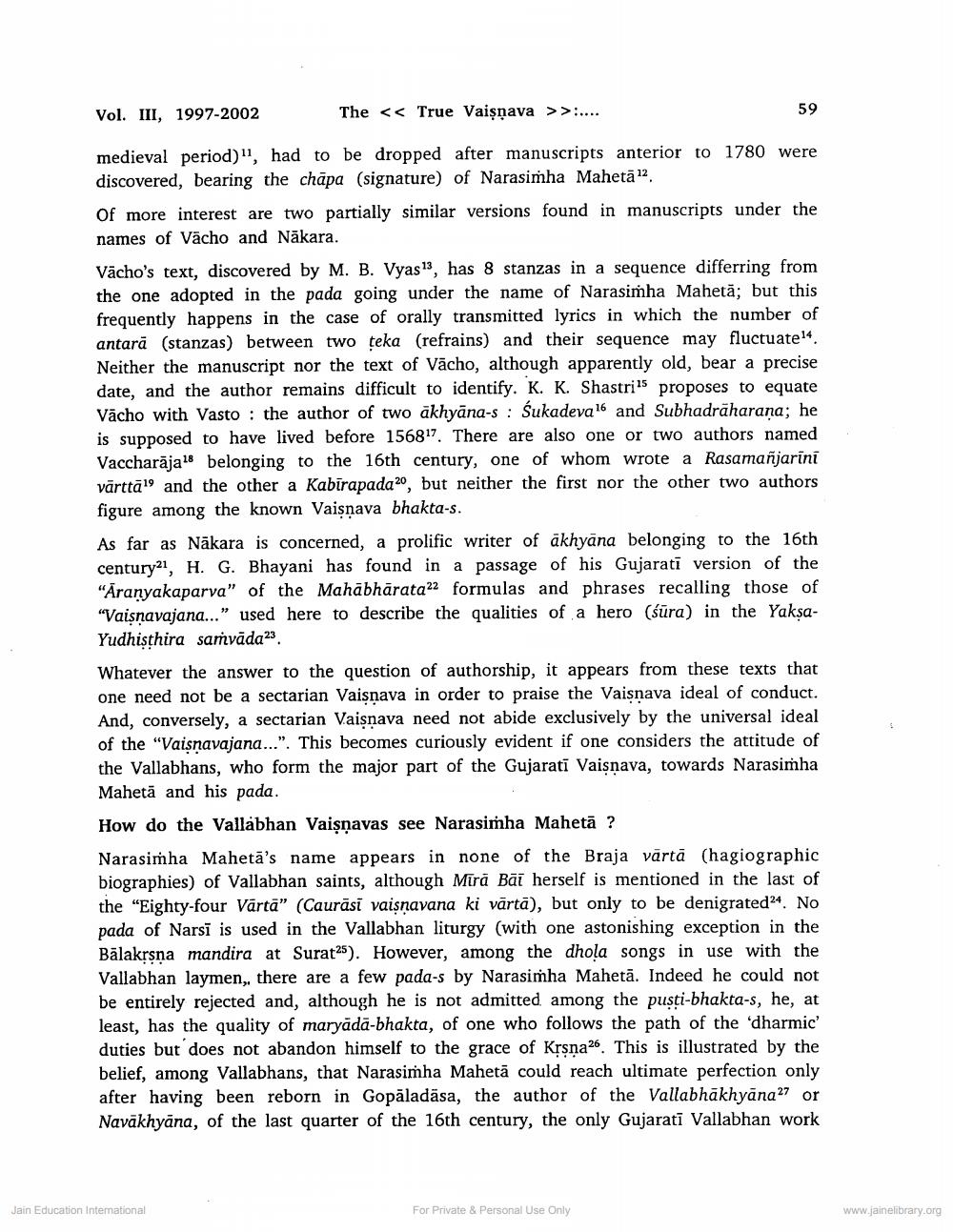________________
Vol. III, 1997-2002
The << True Vaisnava >>:....
59
medieval period)", had to be dropped after manuscripts anterior to 1780 were discovered, bearing the chāpa (signature) of Narasimha Mahetā"2. Of more interest are two partially similar versions found in manuscripts under the names of Vacho and Nākara. Vācho's text, discovered by M. B. Vyas 13, has 8 stanzas in a sequence differring from the one adopted in the pada going under the name of Narasimha Mahetā; but this frequently happens in the case of orally transmitted lyrics in which the number of antarā (stanzas) between two teka (refrains) and their sequence may fluctuate!4. Neither the manuscript nor the text of Vācho, although apparently old, bear a precise date, and the author remains difficult to identify. K. K. Shastri 15 proposes to equate Vācho with Vasto : the author of two ākhyāna-s : Sukadeva 16 and Subhadraharana; he is supposed to have lived before 156817. There are also one or two authors named Vaccharāja18 belonging to the 16th century, one of whom wrote a Rasamañjarini vārttā" and the other a Kabīrapada20, but neither the first nor the other two authors figure among the known Vaisnava bhakta-s. As far as Nākara is concerned, a prolific writer of ākhyāna belonging to the 16th century21, H. G. Bhayani has found in a passage of his Gujarati version of the “Aranyakaparva" of the Mahābhārata22 formulas and phrases recalling those of "Vaisnavajana...” used here to describe the qualities of a hero (śūra) in the YaksaYudhisthira samvāda23. Whatever the answer to the question of authorship, it appears from these texts that one need not be a sectarian Vaisnava in order to praise the Vaisnava ideal of conduct. And, conversely, a sectarian Vaisnava need not abide exclusively by the universal ideal of the "Vaisnavajana...". This becomes curiously evident if one considers the attitude of the Vallabhans, who form the major part of the Gujarati Vaisnava, towards Narasimha Mahetā and his pada. How do the Vallabhan Vaişnavas see Narasimha Mahetā ? Narasimha Mahetā's name appears in none of the Braja vārtā (hagiographic biographies) of Vallabhan saints, although Mira Bāi herself is mentioned in the last of the "Eighty-four Vārtā” (Caurāsi vaisnavana ki vārtā), but only to be denigrated24. No pada of Narsi is used in the Vallabhan liturgy (with one astonishing exception in the Bālakrsna mandira at Surat25). However, among the dhola songs in use with the Vallabhan laymen, there are a few pada-s by Narasimha Mahetā. Indeed he could not be entirely rejected and, although he is not admitted among the pusti-bhakta-s, he, at least, has the quality of maryādā-bhakta, of one who follows the path of the 'dharmic duties but does not abandon himself to the grace of Krsna26. This is illustrated by the belief, among Vallabhans, that Narasimha Mahetā could reach ultimate perfection only after having been reborn in Gopāladása, the author of the Vallabhākhyāna?? or Navākhyāna, of the last quarter of the 16th century, the only Gujarati Vallabhan work
Jain Education Intemational
For Private & Personal Use Only
www.jainelibrary.org




